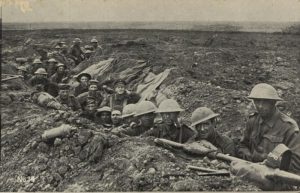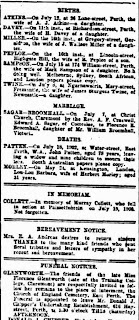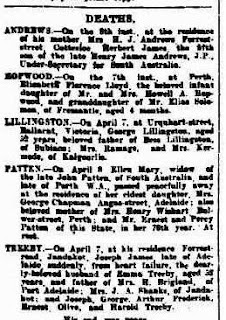Maurice James Coffey, my 1st cousin 3 times removed, wrote to the officer in charge of base records of the AIF in 1932. I found this letter in his service records held by the National Archives of Australia.
A brief transcription is as follows:
Dear Sir
Please supply me with the Regimental Numbers and units of my four brothers
Louis Johnstone Coffey Killed at Messines June 1917
Sylvester Plunkett Coffey deceased
Edward Daly Coffey died TB hospital Adelaide March 1921
Arthur Thomas Coffey enlisted at Albury NSW under the name of Arthur Everard and gave as his next of kin his cousin Thomas Plunkett of Bowna near Albury. I am his next of kin being the eldest and only surviving brother. Arthur died about 1923? after his discharge from the AIF in December 1919.
I wish to perpetuate the memory of my dead brothers who served in the AIF
Yours faithfully
Morris James Coffey
Late Lieut 10th Bn Inf AIF
Such a sad letter, to have four of his brothers who served in World War One all die at war or shortly after.
They all got into some sort of trouble during their military service, whether it was going AWOL for a night, talking back to an officer or something more serious. Several of the brothers neglected to mention on their enlistment forms that they had been convicted of criminal offences prior to their military service also.
There were seven brothers in the family altogether. Christopher Augustin Coffey died when he was fifteen so didn’t serve and it doesn’t appear that Michael Francis Coffey (commonly known as Frank) served either.
Sylvester Plunkett Coffey’s wounds were such that he ended up with hemiplegia, the paralysis of one side of the body. In one description it says that one eye was permanently shut, his mouth drooped, he drooled and had no use of his arm and that his leg was slightly improved. It certainly paints a bleak picture of poor Sylvester. I have found very little more information other than he returned to Adelaide and died in 1920.
So far I have been unable to find a reason for Arthur Thomas Coffey to enlist under a different name. He must have used the name Arthur Everard after his military service as well, as his probate documents note both names. I have yet to find any evidence that he used the name Arthur Everard prior to World War One. In the above letter Maurice is under the impression that Arthur died in 1923 however this isn’t the case. Arthur didn’t die until 1938. Maurice must have found out his mistake as it is him who notifies Base Records of Arthur’s death.
Louis Johnstone Coffey died in the Battle of Messines.
Edward Daly Coffey was in trouble with the law before and after his military service.

1920 ‘IN THE COURTS. SUPREME—CRIMINAL.’, Observer (Adelaide, SA : 1905 – 1931), 31 July, p. 34. , viewed 03 Jun 2017, http://nla.gov.au/nla.news-article165906753
Edward died not long after this on 22 Mar 1921. His time in prison may have worsened his tuberculosis but it may also have prevented him from drinking which it appears was a problem throughout not only his life but that of his brothers as well.
As I find out more about the five Coffey brothers I am adding it to the RSL Virtual War Memorial.


















